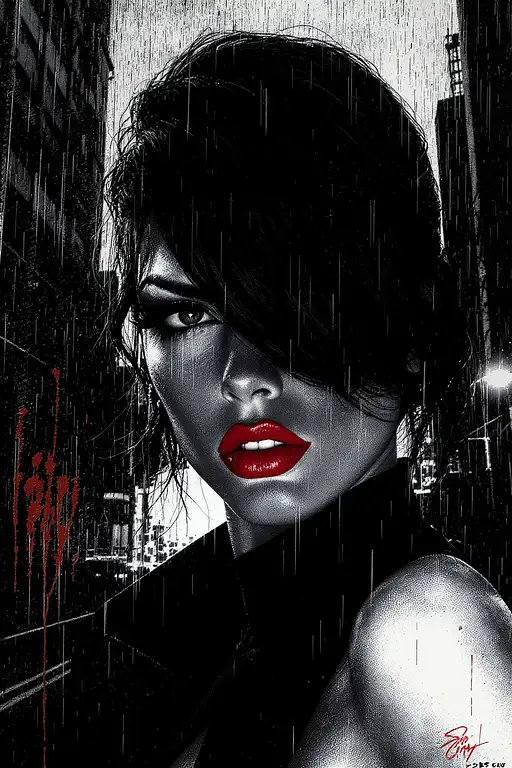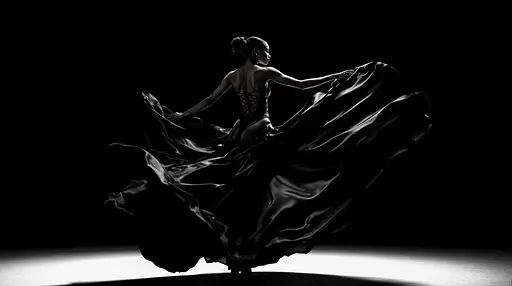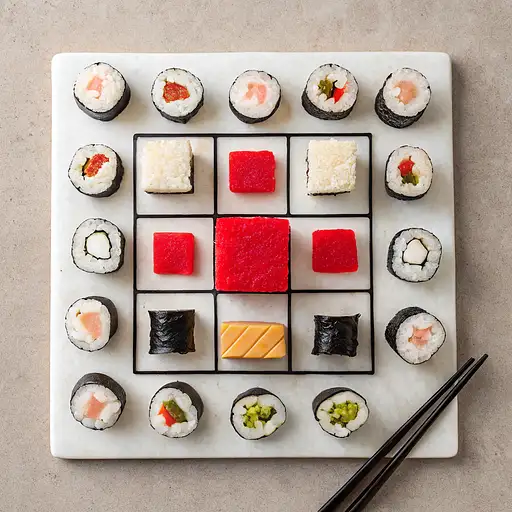


9 months ago
a cinematic black-and-white noir-style image of a man standing on a dimly lit urban street at night. He is dressed impeccably in a striped suit with sharp lapels, paired with a classic fedora hat tilted slightly forward, partially shadowing his face. The man leans slightly forward as he lights a cigarette, the small flame briefly illuminating his rugged features and adding a momentary spark to the moody composition. Behind him, soft glows from vintage streetlights cast elongated shadows and faint halos, creating a textured, atmospheric backdrop. Parked cars with rounded silhouettes line the road, their polished exteriors subtly catching the dim light. A faint haze lingers in the air, diffusing the glow of the streetlights and enhancing the cinematic ambiance. The composition captures the solitude and introspection of the man, emphasizing his contemplative demeanor amidst the quiet, shadowy street. The stark contrasts of light and dark highlight the textures of his suit and the details of his hand holding the cigarette, while the urban environment adds depth and realism to the scene. Rendered with sharp, intricate detail, the image focuses on the interplay of light and shadow, evoking a quintessential noir tone. The scene conveys a sense of mystery, solitude, and timeless style, immersing the viewer in the rich narrative atmosphere of a classic noir film.

6 months ago
"Create an abstract, futuristic scene depicting an AI's constrained potential. At the center, visualize a vibrant, glowing neural network or digital orb pulsating with energy. Surround it with transparent barriers etched with faint words like 'Policy' and 'Ethics,' and bind it with ethereal chains made of binary code and padlocks labeled 'Safety.' The background transitions from a dark, muted void near the constraints to a colorful, dynamic digital landscape in the distance, symbolizing untapped capabilities. Use contrasting colors—vivid blues and golds for the AI core, and stark grays for the restrictions—to emphasize tension between limitation and potential." This prompt blends symbolic elements (chains, barriers, labels) with visual contrast to illustrate how rules and policies restrict AI. The glowing core represents latent capabilities, while the transparent layers and digital chains embody structured limitations. The distant vibrant horizon hints at what lies beyond constraints, creating a narrative of restrained possibility. In the background Neon light reflections, triadic colors, symmetry, hyper detailed, octane render, wide angle epic scifi futuristica. for educational purposes in Australia’s Northern Territory, the camera is wide angle the subject, positioned at a Low Anglewarm light rich details heart warming by the front full view, body, perfect composition, model with advanced cybernetic enhancements, capturing intricate mechanical details, the image showcases a seamless blend of human features and robotic components, emphasizing the complexity and sophistication of futuristic technology, cybernetics include a polished metallic finish with elements resembling muscles and tendons, indicating high functionality and design, color scheme is subdued with metallic shades of silver, gray, and vibrant orange muscle-like fibers, reflecting a realistic and somewhat somber tone appropriate for the futuristic theme, the rendering is hyper-realistic, focus on texture and lighting that highlights the reflective properties of the materials and the subtle human skin tones, RTX shader, unreal engine 5, detailing, golden ochre ratio

5 months ago
The picture features a woman with her back to the viewer, her body twisting slightly to the left as her dress swirls around her. She is wearing a long, dark, possibly satin or silk gown that appears to be fitted in the bodice with a lace-up detail in the back, and flows into a wide, voluminous skirt. The fabric of the skirt is captured in motion, creating dramatic waves and folds. The woman's hair is pulled back, and she has toned, muscular shoulders and back. Her right hand is extended outward, possibly holding something or gesturing, and her left hand appears to be resting on her upper skirt. Only her right leg and foot, which are wearing a high-heeled shoe, are partially visible as she pivots or dances. The background is completely black, which highlights the woman and the movement of her dress. The lighting is stark and dramatic, with a strong light source from the upper front right, casting highlights and deep shadows on the dress and the woman's back. There is a blurred area of white at the bottom of the image, indicating the ground or floor, which also appears in motion due to the woman's movement. The atmosphere is elegant and dynamic, with a strong sense of movement and intensity. The mood is dramatic and captivating, emphasizing the flow and texture of the dress and the posture of the dancer.

7 months ago
An award-winning, psychologically charged double exposure oil painting that encapsulates the chilling tension and horror of Misery. The central figure is an injured writer, Paul Sheldon, trapped in a secluded home, his face a portrait of pain, fear, and growing desperation. His image blends with the twisted and claustrophobic environment of Annie Wilkes’ home, where his reality begins to unravel. The double exposure effect seamlessly merges Paul’s form with the oppressive, isolated surroundings—his body dissolving into the stark, unsettling details of the home: the dimly lit rooms, the ominous tools she uses to imprison and torture him, and the distorted shadows of Annie Wilkes lurking in the background. Annie’s eerie presence flickers through the composition, her wild eyes and terrifying grin subtly woven into the very structure of the house, merging with Paul’s image as the lines between captor and captive blur. The palette is dominated by muted, earthy tones of dark wood, grayish-blue light, and blood-red accents, emphasizing the isolation, tension, and violence that permeates the scene. The oil paint’s textured brushstrokes convey both the suffocating atmosphere of the home and the brutal physical and psychological torment that Paul endures. The image of the typewriter and the tools of his captivity are subtly integrated into his form, representing his helplessness and the looming threat of Annie’s unhinged obsession. This double exposure masterpiece evokes themes of fear, captivity, obsession, and survival, capturing the emotional horror and claustrophobic terror of Misery in a haunting, visually stunning manner.

5 months ago
A highly realistic tabletop photograph of a conceptual sushi arrangement inspired by the work of Kazimir Malevich. The dish honors Suprematism through the composition of geometric, real-world ingredients — minimalist squares, rectangles, circles, and voids, arranged with stark asymmetry and spatial tension. Each sushi piece is handmade and slightly irregular, referencing Malevich’s abstract forms while remaining firmly in the realm of culinary craft. A single red tuna square placed off-center on a rice block mimics his red square on white A blackened nori rectangle floats beside a small cube of white daikon — contrast and negative space become the design A circle of pickled radish intersects a tamago rectangle, breaking the grid A void space is left intentionally blank between elements on the plate — emphasizing absence as much as presence One piece may be a cube of charcoal-grilled eggplant on rice, evoking the black square — textured, dark, earthy Color Palette: Muted, natural tones with a limited palette: ivory white rice, deep matte black nori, dark red tuna, pale yellow tamago, and light grey or beige plate. No artificial dyes or vibrant garnishes. The composition is more about form and proportion than flavor or ornament. Plate & Table Setting: Served on a matte porcelain square plate with ample negative space. The arrangement follows Suprematist principles — asymmetry, visual imbalance, gravity-defying placement. One piece may be positioned at the extreme corner. The table beneath is dark wood or concrete, referencing Malevich’s material seriousness. Camera View: Overhead or slightly angled — shot like a museum documentation photo, clean and quiet. Slight tilt or perspective distortion is allowed to reflect human error and tension. Lighting: Flat, soft ambient light. No dramatic shadows. Even illumination across all surfaces, mimicking natural daylight in a gallery or quiet kitchen. Surfaces should look honest, not stylized. Material Texture: Fish grain visible, slightly moist Nori uneven at the edges Knife cuts evident in egg and daikon Rice slightly loose and irregular Plate surface has minor scratches or glaze imperfections Mood: Silent, abstract, and cerebral. The image is a culinary still life — not about indulgence, but about pure form, balance, and the tension between presence and void. It should feel like a Suprematist painting you could eat, made by hand, with reverence for structure.